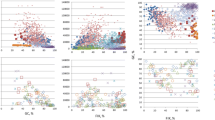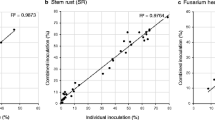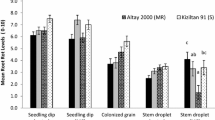Abstract
To determine whether resistance to Fusarium head blight in winter wheat is horizontal and non-species specific, 25 genotypes from five European countries were tested at six locations across Europe in the years 1990, 1991, and 1992. The five genotypes from each country had to cover the range from resistant to susceptible. The locations involved were Wageningen, Vienna, Rennes, Hohenheim, Oberer Lindenhof, and Szeged. In total, 17 local strains of Fusarium culmorum, F. graminearum, and F. nivale were used for experimental inoculation. One strain, F. culmorum IPO 39-01, was used at all locations. Best linear unbiased predictions (BLUPs) for the head blight ratings of the genotypes were formed within each particular location for each combination of year and strain. The BLUPs over all locations were collected in a genotype-by environment table in which the genotypic dimension consisted of the 25 genotypes, while the environmental dimension was made up of 59 year-by-strain-by-location combinations. A multiplicative model was fitted to the genotype by-environment interaction in this table. The inverses of the variances of the genotype-by-environment BLUPs were used as weights. Interactions between genotypes and environments were written as sums of products between genotypic scores and environmental scores. After correction for year-by-location influence very little variation in environmental scores could be ascribed to differences between strains. This provided the basis for the conclusion that the resistance to Fusarium head blight in winter wheat was of the horizontal and non-species specific type. There was no indication for any geographical pattern in virulence genes. Any reasonable aggressive strain, a F. culmorum strain for the cool climates and a F. graminearum strain for the warmer humid areas, should be satisfactory for screening purposes.
Similar content being viewed by others
References
Arseniuk E, Goral T, Czembor HJ (1993) Reaction of triticale, wheat and rye accessions to graminaceous Fusarium spp. infection at the seedling and adult plant growth stages. Euphytica 70:175–183
Daamen R, Langerak CJ, Stol W (1991) Surveys of diseases and pests in the Netherlands. 3. Monographella nivalis and Fusarium spp. in winter wheat fields and seed lots. Neth J Plant Pathol 97:105–114
Denis J-B (1991) Ajustements de modèles linéaires et bilinéaires sous contraintes linéaires avec données manquantes. Rev Stat Appl XXXIX:5–24
Gabriel KR (1978) Least squares approximation of matrices by additive and multiplicative models. J R Stat Soc B 40:186–196
Gauch HG (1988) Model selection and validation for yield trials with interaction. Biometrics 44:705–715
Genstat 5 Committee (1993) Genstat 5 release 3 reference manual. Clarendon Press, Oxford
Jolliffe IT (1986) Principal component analysis. Springer, Berlin Heidelberg, New York
Kempton RA (1984) The use of biplots in interpreting variety by environment interactions. J Agric Sci 103:123–135
Lemmens M, Bürstmayr H, Ruckenbauer P (1993) Variation in Fusarium head blight susceptibility of international and Austrian wheat breeding material. Bodenkultur 44:65–78
Marasas WFO, Nelson PE, Toussoun TA (1984) Toxigenic Fusarium species, identity and mycotoxicology. The Pennsylvania State University Press, University Park and London
Mesterhazy A (1977) Reaction of winter wheat varieties to four Fusarium species. J Phytopathol 90:104–112
Mesterhazy A (1978) Comparative analysis of artificial inoculation methods with Fusarium spp. on winter wheat varieties. Z Phytopathol Z 93:12–25
Mesterhazy A (1983) Breeding wheat for resistance to Fusarium graMinearum and Fusarium culmorum. Plant Breeding 91:295–311
Mesterhazy A (1984) A laboratory method to predict pathogenicity of Fusarium graminearum in field and resistance of wheat to scab. Acta Phytopathol Acad Sci Hung 19:205–218
Mesterhazy A (1987) Selection of head blight resistant wheats through improved seedling resistance. Plant Breed 98:25–36
Mesterhazy A (1988) Expression of resistance of wheat to Fusarium graminearum and F. culmorum under various experimental conditions. J Phytopathol 123:304–310
Mesterhazy A (1990) Über die Möglichkeiten und Praktik der Züchtung widerstandsfähiger Weizensorten gegen Ährenfusariose. Bericht über 41. Arbeitstagung der Vereinigten Österreichischen Pflanzenzüchter, Gumpenstein, pp 253–234
Miedaner T, Borchardt DC, Geiger HH (1993) Genetic analysis of inbred lines and their crosses for resistance to head blight (Fusarium culmorum, F. graminearum) in winter rye. Euphytica 65:123–133
Nirenberg HI (1981) A simplified method for identifying Fusarium spp. occurring on wheat. Can J Bot 59:1599–1609
Patterson HD, Thompson R (1971) Recovery of inter-block information when block sizes are unequal. Biometrika 58:545–554
Robinson GK (1991) That BLUP is a good thing: the estimation of random effects. Stat Sci 6:15–51
Saur L (1991) Recherche de géniteurs de résistance à la fusariose de l'épi causée par Fusarium culmorum chez le blé et les espèces voisines. Agronomie 11:535–541
Saur L, Trottet M (1992) Héritabilité de la résistance à la fusariose de l'épi et sélection récurrente dans une population de blé tendre. Agronomie 12:297–302
Searle SR (1971) Linear models. Wiley, New York
Snijders CHA (1990) Genetic variation for resistance to Fusarium head blight in bread wheat. Euphytica 50:171–179
Snijders CHA (1994) Breeding for resistance to Fusarium in wheat and maize. In: Miller JD, Trenholm HL (eds), Mycotoxins in grain: compounds other than aflatoxin. Eagan Press, St. Paul, Minnesota, USA, pp 37–58
Snijders CHA, Eeuwijk FA van (1991) Genotypexstrain interactions for resistance to Fusarium head blight caused by Fusarium culmorum winter wheat. Theor Appl Genet 81:239–244
Snijders CHA, Krechting CF (1992) Inhibition of deoxynivalenol translocation and fungal colonization in Fusarium head blight resistant wheat. Can J Bot 70:1570–1576
Stack RW, McMullen MP (1985) Head blighting potential of Fusarium species associated with spring wheat heads. Can I Plant Path 7:79–82
van Eeuwijk FA (1995) Multiplicative interaction in generalized linear models. Biometrics (in press)
Verdooren LR (1992) Practical aspects of the estimation of varietal contrasts from variety trials. Biuletyn oceny odmian 24–25:105–137
Wilcoxson RD, Kommedahl T, Ozmon EA, Windels WE (1988) Occurrence of Fusarium species in scabby wheat from Minnesota and their pathogenicity to wheat. Phytopathology 78:586–589
Zadoks JC, Rijswijk FH (1984) Agro-ecological atlas of cereal growing in Europe, vol.3: atlas of cereal diseases and pests in Europe. PUDOC, Wageningen
Author information
Authors and Affiliations
Additional information
Communicated by J. MacKey
Rights and permissions
About this article
Cite this article
van Eeuwijk, F.A., Mesterhazy, A., Kling, C.I. et al. Assessing non-specificity of resistance in wheat to head blight caused by inoculation with European strains of Fusarium culmorum, F. graminearum and F. nivale using a multiplicative model for interaction. Theoret. Appl. Genetics 90, 221–228 (1995). https://doi.org/10.1007/BF00222205
Received:
Accepted:
Issue Date:
DOI: https://doi.org/10.1007/BF00222205




